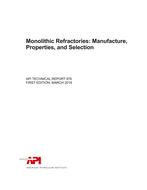Description
This standard contains requirements for defining the seismic design procedures and criteria for offshore structures and is a modified adoption of ISO 19901-2. The intent of the modification is to map the requirements of ISO 19901-2 to the United States? offshore continental shelf (U.S. OCS). The requirements are applicable to fixed steel structures and fixed concrete structures. The effects of seismic events on floating structures and partially buoyant structures are also briefly discussed. The site-specific assessment of jack-ups in elevated condition is only covered to the extent that the requirements are applicable.This document defines the seismic requirements for new construction of structures in accordance with API 2A-WSD, 22nd Edition and later. Earlier editions of API 2A-WSD are not applicable.
The majority of the ISO 19901-2 document is applicable to the U.S. OCS. Where necessary, this document provides guidance for aligning the ISO 19901-2 requirements and terminology with API. The key differences are as follows.
a)API 2EQ adopts the ISO 19901-2 site seismic zones in lieu of those previously used in API 2A-WSD, 21st Edition and earlier.
b)Only the maps in Figure B.2 are applicable, in lieu of those previously used in API 2A-WSD, 21st Edition and earlier.
c)ISO 19901-2 seismic design approach is also adopted here with:
- a two-level seismic design in which the structure is designed to the ultimate limit state (ULS) for strength and stiffness and then checked to the abnormal or accidental limit state (ALS) to ensure that it meets reserve strength and energy dissipation requirements;
- the seismic ULS design event is the extreme level earthquake (ELE) [this is consistent with, but not exactly the same as the strength level earthquake (SLE) in API 2A-WSD, 21st Edition and earlier];
- the seismic ALS design event is the abnormal level earthquake (ALE) [this is consistent with, but not exactly the same as the ductility level earthquake (DLE) in API 2A-WSD, 21st Edition and earlier].
Only earthquake-induced ground motions are addressed in detail. Other geologically induced hazards such as liquefaction, slope instability, faults, tsunamis, mud volcanoes, and shock waves are mentioned and briefly discussed.
The requirements are intended to reduce risks to persons, the environment, and assets to the lowest levels that are reasonably practicable. This intent is achieved by using:
- seismic design procedures which are dependent on the platform?s exposure level and the expected intensity of seismic events;
- a two-level seismic design check in which the structure is designed to the ultimate limit state (ULS) for strength and stiffness and then checked to abnormal environmental events or the accidental limit state (ALS) to ensure that it meets reserve strength and energy dissipation requirements.
For high seismic areas and/or high exposure level fixed structures, a site-specific seismic hazard assessment is required; for such cases, the procedures and requirements for a site-specific probabilistic seismic hazard analysis (PSHA) are addressed. However, a thorough explanation of PSHA procedures is not included.
Where a simplified design approach is allowed, worldwide offshore maps are included in Annex B that show the intensity of ground shaking corresponding to a return period of 1000 years. In such cases, these maps may be used with corresponding scale factors to determine appropriate seismic actions for the design of a structure.
Product Details
- Edition:
- 1st
- Published:
- 11/01/2014
- Number of Pages:
- 104
- File Size:
- 1 file , 7.3 MB
- Part of:
- API Offshore Structure Standards Set
- Product Code(s):
- GG2EQ01, GG2EQ01, GG2EQ01
- Note:
- This product is unavailable in Cuba, Iran, North Korea, Syria




